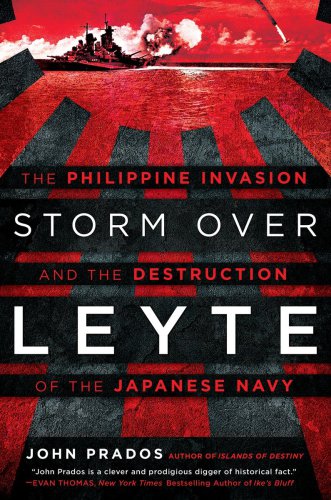
Storm Over Leyte
The Philippine Invasion and the Destruction of the Japanese Navy
کتاب های مرتبط
- اطلاعات
- نقد و بررسی
- دیدگاه کاربران
نقد و بررسی

May 9, 2016
In this well-researched and detailed account, Prados (Islands of Destiny), an experienced historian and professional intelligence analyst, examines the Battle of Leyte Gulf, the largest naval battle of WWII, which resulted in the destruction of the Japanese fleet as an effective combat force. Prados writes through the prism of an intelligence professional and focuses two thirds of the work on the battle’s strategic setting as the opposing sides analyzed intelligence and attempted to interpret each other’s intentions. The opening sections can be difficult reading, but in the fast-paced final third, Prados paints a clear and exciting picture of the major naval engagements themselves. The strongest part of the book is Prados’s description of the U.S. intelligence apparatus that meticulously tracked the Japanese military’s communications, leveraging a small army of brilliant linguists, radio operators, cryptologists, and analysts. The work is exceedingly balanced and provides detailed portraits of the personalities of the Japanese commanders, their understanding of events, and their decision-making processes. This is not a book for the casual reader of WWII or naval history; its nuanced approach and new facts and analysis will be of greatest interest to serious naval historians. Agent: Michael Congdon, Don Congdon Associates.

June 1, 2016
An in-depth study of the clash of the Japanese and Allied navies in Leyte Gulf, possibly the greatest naval battle of the 20th century.Veteran military historian Prados (The U.S. Special Forces: What Everyone Needs to Know, 2015, etc.) has researched both U.S. and Japanese intelligence reports from the era, giving unusual insight into the decision-making on both sides. The Philippine invasion was a key step in the Allied strategy of securing bases for what was expected to be an invasion of the Japanese homeland. It was also one of Gen. Douglas MacArthur's cherished goals, recapturing territory he had lost to the Japanese after Pearl Harbor. Meanwhile, the Japanese, reeling from a series of defeats by U.S. forces, decided to throw everything into a decisive naval battle, hoping to lay the ground for a negotiated peace. Prados goes into great detail on the buildup and planning on both sides, with particularly close looks at the intelligence reports available to the planners. The Japanese plans were practically "an open book to the U.S." On the other hand, the Japanese knew enough to avoid being caught off guard, though they were hampered by having to protect several likely targets. Prados points to mistakes on both sides, notably U.S. Adm. William Halsey's taking the bait of a Japanese decoy maneuver that lured his carriers away from the main battle. In the end, while both navies took substantial damage, the Japanese navy was all but obliterated. Some readers may find the author's buildup to the battle itself a bit long; it's nearly halfway through the book before the first ship-to-ship combat, submarine attacks that sank two Japanese cruisers on the way to Leyte. Other readers may wish for a list of key personnel, especially on the Japanese side, early in the book. While casual readers may be put off, this is still a valuable resource, with a wealth of detail on all aspects of the battle. A book every serious World War II student will want.
COPYRIGHT(2016) Kirkus Reviews, ALL RIGHTS RESERVED.

























دیدگاه کاربران